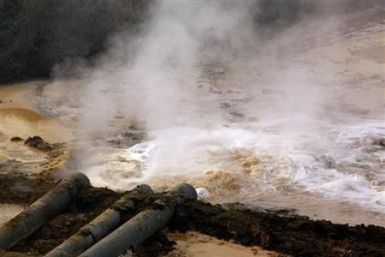New evidence suggesting the existence of water flowing on Mars indicates the possibility for life to exist on the Red Planet.
Two energy blasts from the sun are causing "tsunamis in space."
The first episode of a "The Office" style mocumentary premier on Thursday night in Afghanistan.
A new theory published in scientific journal Nature states that the primary collision of two moons that once orbited Earth is the reason why one side of our present moon is a bit lopsided and its far side (which is not visible from earth) is much rockier.
Scientists on Thursday said that satellite images of Arctic sea ice show that it is melting at a near-record pace.
A primordial collision of two moons that once orbited Earth explains why the present-day moon is a bit lopsided and its far side much rockier than the lunar surface facing our planet, scientists said Wednesday.
The collision of two moons orbiting Earth may have resulted in the planet's present-day lopsided moon, scientists say. Research published on Wednesday in the journal Nature states that in its younger years, Earth's moon was shadowed by a lightweight companion that was about one-thirteenth of its mass.
NASA is tracking the tropical storm Emily as it approaches Haiti and other nations.
A small second moon may once have orbited Earth until it slammed into the other one, enabling two distinct sides, a new study said. The second moon would have been about 750 miles wide and may have been created by the same collision between the planet and huge object that scientists think helped create our moon, astronomers said.
Scientists believe that they may be able to finally explain why the two sides of the lunar body are so different from each other. A new study published in the journal Nature has suggested that Earth originally had two moons in orbit around it until a second moon flattened itself to the bigger moon more than 4 billion years ago.
Once upon a time, a second moon orbited the Earth, but after a slow-motion collision with its bigger sister, our planet was left with one, scientists say. Astronomers believe that this collision, which lasted several hours, can explain the moon's symmetry.
Among the mysteries lying on the far side of the Moon are why it has a thick mountainous crust, while the near side which we see has low-lying lava plains and a much thinner crust than the far side. Scientists believe they may be able to finally explain the moon's asymmetry.
Earth once had two moons a small second moon until the two moons got smashed into each other to create a big lunar body.
Our planet's lopsided moon may have swallowed up its smaller sibling after a collision, which may have resulted in its asymmetric terrain, scientists propose. Erik Asphaug, a planetary scientist at the University of California, Santa Cruz, and his colleague Martin Jutzi recently wrote an article about the creation of the moon, which is published in the journal Nature.
A second moon orbited the Earth but a slow-motion collision with its bigger sister left our planet with one, scientists say. Astronomers believe that this collision, which lasted several hours, can explain the moon's asymmetry.
A new study is suggesting that Earth had two moons that crashed and formed one. Computer simulations are hinting that a second moon flattened itselt to the bigger moon, and this theory could explain why the two sides of the moon are so different from each other.
NASA's Dawn spacecraft, the first ever to orbit an object in the main asteroid belt, has provided striking latest images of the asteroid Vesta, the second-most largest in the asteroid belt.
Astronomers have spotted an asteroid close to Earth and moving in the same orbit around the Sun. The rock is 200-300 m wide and sits in front of our planet and is non-threatening.
Global warming predictions have followed UN models and trends in describing how Earth traps heat due to carbon dioxide. The increased gases and rising temperatures would create large amounts of water vapors to develop into clouds. Those clouds would trap larger amounts of heat and devastate the planet's ecosystem leading to the end of mankind.
Asteroid 2010 TK7 was discovered by NEOWISE, the asteroid-hunting section of NASA's WISE mission. It was confirmed as the first Earth Trojan after follow up observations with the Canada-France-Hawaii Telescope on Mauna Kea in Hawaii.
Japanese imports of rare earths from China fell 13 percent in June to 1,386 tonnes as a rise in prices made it unaffordable to many Japanese hi-tech companies.
South Korea forecasts even more rain as emergency workers are still entrenched in a battle against floods and landslides that have killed at least 41 people.







































